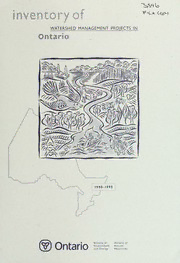
Inventory of watershed management projects in Ontario : 1990-1995 PDF
Preview Inventory of watershed management projects in Ontario : 1990-1995
inventory of WATERSHED MANAGEMENT PRQ|ECTS IN Ontario Ministry of Ministry of Ontario Environment Natural and Energy Resources INVENTORY OF a WATERSHED 1 MANAGEMENT PROJECTS ONTARIO IN /rv,i ^i)M^ i I %> i S acknowledgements The co-ordinators of this project would like to express their thanks to the watershed management all who practitioners voluntarily provided the data used to develop the database and subsequent report. Without their participation and their ongoing effort in collecting, communicating and editing the data, completion'of this project would not have. been possible. For a complete of project contributors, list refer to page 105. OBidHHa contents ACKNOWLEDGEMENTS PREFACE preface A number of terms that are frequently used in this report are defined below using definitions identified in the final report of the Watershed Planning Implementation Project Management .Committee.' A watershed is an entire area, both land and water drained by a watercourse and its tributaries.A subwatershed is an area drained by an individual tributary to the mam watercourse. Watershed nnanagement is a process of managing human activities in an area defined by watershed boundaries in orderto protect and rehabilitate land and water and associated aquatic and terrestrial resources, whi-le recognizing the benefits of orderly growth and development.The goal is to contribute to the environmental, social and economic well-being ofthe area on a sustainable basis.Watershed management is a tool to assist those making decisions regarding land and water use.There are four phases: I) issue identification and data gathering; 2) analysis and planning; 3) implementation; 4) monitoring. The practice ofwatershed managemelit has evolved overthe last few decades to become more comprehensive by integrating and addressing a broader range of resource and environmental protection issues and more thoroughly evaluating the important linkages between land and water, between surface and groundwater, between water quality and water quantity and between watershed management and municipal planning. Watershed planning practitioners have found that this comprehensive approach to watershed management has resulted in an overall savings oftime and money It is expected that watershed management will continue to evolve as experience increas- es, more information becomes available, study methodology improves and as study issues are betterdefined. Watershed Planning Implementation Project Management Committee. An Evaluation of Watershed I Management in Ontano - FinalReport.Toronto, 1997 p.2. IV H Ap T E R introduction This document contains the findings of a joint inventory of the Ministry of Environment and Energy (MOEE) and the Ministry of Natural Resources (MNR) entitled: Inventory ofWatershed Management Projects in Ontario, . 1990-1995. This watershed management inventory consists of information gathered from watershed management practitioners.The information which was collected and is contained in this report helps to: • identify the extent ofwatershed management in Ontario; • inform others ofspecific ongoing and completed studies; • foster communications between future community participants and experienced watershed management practitioners; • provide data that can be used to develop additional knowledge and insights into watershed management activities. Chapter 1 introduces the data. A map illustrates the location ofeach project in Ontario and a legend identifies the project name. Chapter 2 also elaborates on potential data uses. Chapter 3 is the focus ofthe report. It contains 16 findings displayed in a question and answer format.Wherever possible, the answer is accompanied by a pie chart, bar chart or table to illustrate the trend, distribution or typical value.This is by no means an exhaustive list offindings, but a sample ofthe kinds ofstatistics that can be generated by sorting and querying the data. Chapter 4 concludes the report and identifies how to go about registering a watershed management project that has been missed in this report or was initiated since 1995. rKjkm^ ^^^. f f ' Hi X, kV ^ fit r-r-< ^^^i ^ 1> //^ CHAPTER data Eighty-seven watershed management projects have been initiated between 1990 and 1995 according to the information provided by practitioners. Detailed information has been gathered on each of these projects under the following categories: registration information; study area characteristics; plan completion and implementation; financial information and study participation. The map on the following page illustrates the location ofeach study.To help the PULLOUT MAP reader identify the projects, a reference number has been assigned to each (between I and 87).The legend contains a list ofthe projects in alphabetical order and their corresponding reference number followed by receiving stream, mam land use-and status ofthe studyA one-page printout identifying additional information on each project is provided in Appendix B. These one-page printouts can be analysed individually oras a group.The information that is derived can be applied in a number ofways.Whetherthe reader is with a conservation authority, municipality, community group, development interest, environmental consultant, provincial ministry, or is a private land owner/resident, the data can help the readerto: • become more aware of the number and location of watershed management activities in Ontario; • get in touch with the lead agency to: - obtain additional up-to-date site-specific information on the project such as study issues, plan recommendations and implementation activities: - provide expertise based on experience with similarwatershed management activities; - inquire about opportunities to participate on this or future projects (volunteer assistance, community outreach, public consultation); -.inquire about individual stewardship practices and activities that will protect and/or improve the health ofthe watershed; • become more aware of local land and resource use issues which will in turn help decision-makers to: - develop appropriate policy, best management practices and supporting programs that will help to sustain a healthy ecosystem such as: pollution prevention; resource allocation and land use planning; environmental remediation; resource conservation/protection; resource stewardship; • obtain important scientific data which can be used to: - identify interactions and relationships amongst groundwater, surface water, valley lands, wildlife, habitat, wetlands, woodlots,greenspace; - determine potential cumulative effects or environmental concerns related to .certain activities on the land; - provide valuable background dataand additional monitoring results forfuture studies. table I LIST OF WATERSHED MANAGEMENT PROJECTS
